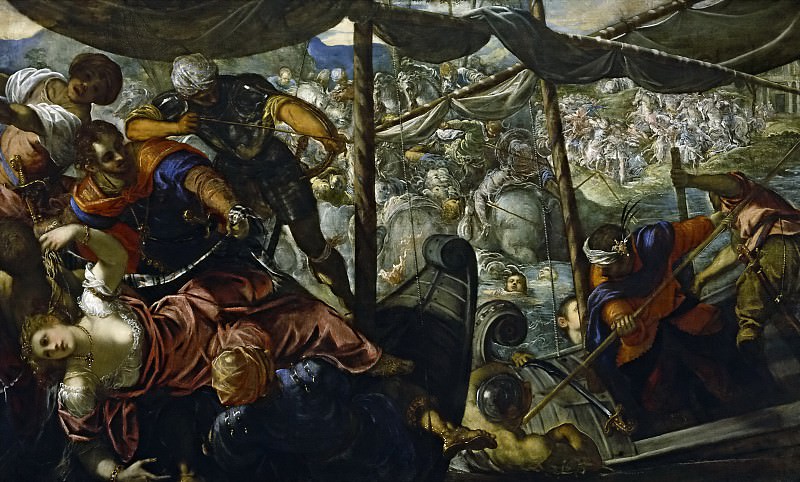Tintoretto, Jacopo Robusti – El rapto de Helena Part 1 Prado museum
Part 1 Prado museum – Tintoretto, Jacopo Robusti -- El rapto de Helena
Edit attribution
Download full size: 2944×1771 px (2,0 Mb)
Back to album: Part 1 Prado museum
Jacopo Tintoretto’s painting The Abduction of Helena illustrates the ancient Greek myth of the abduction of the beautiful Helen. Tintoretto was creating during the late Renaissance, so the myths of Ancient times were incredibly popular and in demand. However, the master decided to bring those momentous events from many centuries ago into his real world. Therefore, in this painting we see Elena’s abduction not in ancient times, but in the 16th century. The protagonist of the painting, of course, is Helen.
Description of Tintoretto’s painting "The Abduction of Helena
Jacopo Tintoretto’s painting The Abduction of Helena illustrates the ancient Greek myth of the abduction of the beautiful Helen. Tintoretto was creating during the late Renaissance, so the myths of Ancient times were incredibly popular and in demand. However, the master decided to bring those momentous events from many centuries ago into his real world. Therefore, in this painting we see Elena’s abduction not in ancient times, but in the 16th century.
The protagonist of the painting, of course, is Helen. She was considered the most beautiful woman, not only in Greece, but all over the world. Some called her a goddess, referring to the myth, which states that she is the daughter of Zeus himself. The girl is depicted in the lower left corner of the work. Her body seems to disobey her, so the warriors barbarically took her in their arms and forcefully drag her aboard the boat. There is pain, loss and helplessness in the girl’s eyes. She is taken away from her beloved husband Menelaus and daughter Hermione. It seems as if Helena has been stolen straight from the king’s chambers - she is wearing rich, gold jewelry, her hair neatly braided. But the wife of the King of Sparta could not be treated so cruelly: the red cloak was badly wrinkled, and the snow-white dress fell off her shoulders, exposing her breasts.
The culprit of this inhuman abduction is Paris, who has been won over by Helena’s beauty. He is depicted by the artist in bright blue and orange clothing. The man is holding a white ribbon. One gets the impression that it is with this ribbon that the woman will be tied.
Alternative title of the painting is "Christian battle with the Turks". From the title it becomes clear why many of the men in the painting are dressed in Arabic clothing, with long dresses and turbans on their heads.
The foreground is painted in great detail, dominated by bright colors. The background is more like a light, fuzzy pattern - all the objects merge, showing the insignificance of what is happening outside the boat.
Кому понравилось
Пожалуйста, подождите
На эту операцию может потребоваться несколько секунд.
Информация появится в новом окне,
если открытие новых окон не запрещено в настройках вашего браузера.
You need to login
Для работы с коллекциями – пожалуйста, войдите в аккаунт (open in new window).




















You cannot comment Why?
The artist employs a dramatic use of light and shadow to heighten the sense of turmoil. Strong illumination focuses on key figures – notably the central woman and several of her captors – creating stark contrasts against areas shrouded in darkness. This technique not only directs the viewers eye but also contributes to an atmosphere of tension and uncertainty. The murky, indistinct background suggests a vast body of water, populated by numerous vessels and soldiers, further emphasizing the scale and complexity of the event.
The arrangement of figures is deliberately crowded and dynamic. Bodies overlap and intertwine, creating a sense of claustrophobia and immediacy. Diagonal lines dominate the composition, contributing to the feeling of movement and instability. The artist’s brushwork appears loose and expressive, adding to the overall impression of disorder and urgency.
Beyond the immediate narrative of abduction, several subtexts emerge. The opulent clothing of the central woman suggests a position of power or privilege, making her capture all the more significant. The presence of turbans hints at an Eastern influence, potentially indicating a clash between cultures or civilizations. The scene’s inherent violence and struggle could be interpreted as a commentary on themes of conflict, betrayal, and the abuse of power. The overall effect is one of dramatic intensity and emotional complexity, inviting contemplation about the motivations and consequences of human actions within a context of political upheaval.